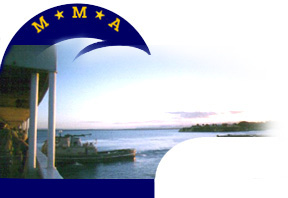
Captain's Log for Tuesday, 1 February 2000
|
As of 0700 Eastern Standard time, 1200 GMT and 1400 ship time, the Empire State was enroute to Barcelona, Spain and located at 36 degrees 03 minutes North Latitude, 017 degrees 00 minutes East Longitude. That put the ship approximately 120 miles south east of the southern tip of Sicily. We were steering a course of 273 degrees, making good a speed of 12 kts. The weather was cloudy with winds out of the west at 5 knots. Seas were 4 to 6 feet and the ship was riding well. The air temp was 54 degrees and the sea temp was 60 degrees. Barometric pressure was 1027 millibars of mercury. Depth of water beneath the keel: 2030 Meters. CAPTAIN'S LOG Guest log author Captain Dave Mackey of the MMA Department of Marine Transportation wrote today's entry. Dave is the Deck Training Coordinator for the 2000 Sea Term. "Days like yesterday make my job completely worthwhile. My colleagues (Captain Tim Brady of Plymouth, MA and Captain Ed Bruce of New Bedford, MA) and I spend the academic year educating deck cadets about the art and science of navigation and seamanship. We use every technique and training aid available, ranging from very expensive, technically complex bridge simulators and liquid cargo loading simulators to the tried and true chalkboard/lecture method. There are times, however, when like most college professors, I wonder if the information presented is being absorbed. Yesterday's performance by the deck cadets on watch positively answered that question. After spending three wonderful days touring Athens, visiting the Acropolis and walking amidst ancient history, the time came to depart Piraeus and leave our new found friends behind. Departure from any crowded port means plenty of hard work and Piraeus is one of the world's busiest harbors. For the "Deckies", leaving the pier means operating powerful deck winches and hauling heavy mooring lines aboard as shipmates quickly and carefully stow them in the cramped line lockers below. It means consulting with the Harbor Pilots, carefully directing tugboats, and deftly managing the complex navigation situation while clearly communicating ship propulsion commands to equally busy cadets working the engineroom. There is nothing I have watched that is quite like it. Getting underway has a grace to it as Cadets move tons of machinery slowly and quietly into the awaiting stream. Safely navigating out of busy ports can raise adrenaline levels to new highs, but the experience also can deliver immediate satisfaction for a job well done. The Empire State operates on a single premise, professional teamwork. We stress the importance of that constantly, in everything that we do. The cadets on watch yesterday treated us to a practical illustration of the subject. As the Cadet Officer of the Watch Stephen Siminski (North Smithfield, RI) ordered "let go all lines fore and aft", I observed 1/C Cadet Thomas Pimentel (Panama City, Panama), expertly organize and manage his team of 26 cadets and quickly the massive bow lines came aboard. On the stern, Cadet 1/C Chris Tuckey (Homer, NY) and his crew hauled the heavy stern lines onto the after deck. Meanwhile, back on the Bridge, Siminski worked with the Harbor Pilot and Captain Bushy to carefully coordinate the powerful tugboats and the ship backed and turned in the congested harbor. I smiled inwardly. These young people are suddenly professionals. Together, they safely and efficiently completed one of the most difficult operations in the Maritime Industry. As an added benefit to an already good day, Captain Bushy decided to deviate from our intended track and set course for the Strait of Stenon Elafonisou, between the mainland of Peloponnisos and Nikos Island. This maneuver set the stage for Cadet 1/C John Miller (Westport, CT) to shine. He expertly conned and navigated Empire State through the narrow passage. What a treat to watch. He steered around other ships with the confidence of a First Mate as he discussed his intentions on the bridge-to-bridge VHF radio. At this point, I fully realized that the cadets have indeed listened and learned. More importantly, they have acquired the knowledge, confidence and ability of fine officers. Then, the perfect ending to a perfect day. We emerged from the confines of the narrow Strait to see the most beautiful sunset of the year. People quietly gathered at the rails as the word quickly passed from deck to deck. We marveled as the spectrum of light painted the heavens and the rare hues of red, purple and orange began to slowly fade into dusk. Then as the final vestiges of the winter sun slipped into the quenching sea, brilliant beams of light suddenly pierced the darkening horizon. The sea where the sun had gone momentarily glowed. We then witnessed a rare solar phenomena, the "Green Flash", where the sun's light breaks into its component colors and a flash of green colors the sky. Ah, such is the life of a Deckie. See you tomorrow..." QUESTIONS FOR WEDNESDAY 02 FEBRUARY 2000 GEOGRAPHY: The Empire State is just two days away from her arrival in Spain. Off Spain's east coast in the Mediterranean are the Balearic Islands. What is the largest island in the Balearic Island chain? SCIENCE: The sea bottom is divided into three areas. What are they? HISTORY: What General led a mutiny against the government of Spain in 1936 that eventually resulted in a three-year civil war? MATH: Complementary angles have a sum of______degrees? Supplemental angles havea sum of______degrees? ANSWERS FOR TUESDAY 01 FEBRUARY 2000 GEOGRAPHY: The Iberian Peninsula SCIENCE: The Greenhouse Effect. HISTORY: England. King Phillip II sent his invincible Armada to invade England, but its destruction cost Spain its supremacy...and never again played a major role in Europe. MATH: 45 degrees
|
|
||||||||||||||||||||||||||||||||||||||||||||||||||